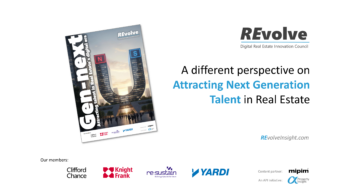We live in a digital age consumed with instantaneous access to information. Ninety percent of the world’s data has been generated in the past two years, nearing 2.5 quintillion bytes each day. With 4.9 billon unique mobile users, 8.4 billion Internet of Things (IoT) devices, and innumerable unstructured transactions generated from the web and social media each second, the global datasphere’s growth rate dwarfs Moore’s Law.
Our ability to transform bits and bytes of data into actionable real-time information, coupled with predictive analytics, is still in its infancy. As companies connect these disparate data points, new innovative opportunities will emerge, and long standing processes will be disrupted. Agile tech savvy firms will unlock creativity, bringing new solutions to market at an accelerated pace. To stay competitive, how do traditional businesses embrace today’s digital first paradigm, that empower employees to achieve more through connected data?
In practice, the heart of our ubiquitous digital universe is a comprehensive ecosystem designed to deliver collaboration and transparency while supporting a corporate vision. To put this into a business context, we invested in a comprehensive overhaul of our long-established residential leasing process. Our goal was to reduce the number of system touch points, automate manual processes, connect disparate unsynchronised silos of information, and provide a greater level of self-service. Secondarily, we would replace Excel as the reporting tool of choice with analytic platforms delivering real-time insight, and visibility into trends fostering a proactive management style.
Based on anecdotal conversations we started to analyse a broad spectrum of roles and responsibilities. It became apparent many daily tasks had become disconnected and layered with unnecessary duplication. As we assessed the way people worked, our end users struggled to visualise the possibilities and were becoming increasingly uncomfortable with change. This dilemma is one every agent of change has faced, knowing without stakeholder’s support, moving forward is fraught with risk and uncertainly.
To rebuild confidence and trust in technology, we turned to a new digital approach to illuminate our vision: storyboarding. Through a series of meetings with key employees, we delved into current processes, pain points, system usability, and reporting requirements. The result utlised a graphical UX / UI approach that brought our findings to life in a simple, intuitive fashion. Through a « Business Lifecycle Storyboard, » our end users were able to clearly visualise how technology would enhance their daily tasks and interactions with prospects and clients.
A supplemental “Technical Workflow Storyboard” provided programmers with a roadmap to accomplish our goals. These detailed design specifications translated each task into four main components, system touch points, process inputs, process outputs and reporting parameters. Through the visualisation process, we were quickly able to discern no single integration method would satisfy our comprehensive application integration requirements. After reviewing each platform’s architecture, we blended Application Program Interfaces (API), SaaS Integration Platforms, JavaScript Object Notation (JSON), Apex code and custom application interfaces to address our bidirectional and unidirectional data exchanges.
During our development cycle, the intrinsic value of preparing detailed workflow process blue prints, with accompanying swim-lane diagrams, became evident. It guided our strategic in-depth review of each application’s ERD (Entity Relationship Diagram), focusing on table indexes and field attributes essential to successful data mapping. Furthermore, the creation of custom staging tables facilitating field level transformation based on business process triggers were developed to maintain system integrity.
With disparate data silos now connected, our employees had the ability to see trends and behavioral patterns across the entire lifecycle, building a foundation for strategic engagement. Through an intuitive graphical interface, managers and analysts could also visualise data from different viewpoints empowering them to make more accurate and timely business decisions. Over time, as historical data points are collected, new patterns will emerge allowing dynamic decision making to drive revenue increases and operating efficiencies.
Cyber security risks are growing daily, and with proprietary data, intellectual property, and perhaps a firm’s competitive advantage traversing the cloud our vulnerabilities grow as well. When constructing system interfaces and data connections, always incorporate a few simple precautionary cyber guidelines:
- Require VPN connections for data exchange;
- Whitelist traffic using firewall rules;
- Encrypt data at 256 AES, both in transit and at rest;
- Implement strong passwords policies;
- Monitor system intrusion alerts.
In our digital age, where we are continually connected and bombarded with information, filtering out the noise can be a gateway to knowledge. To quote Microsoft’s CEO Satya Nadella, « When you change the way you see the world, you change the world you see.” By empowering employees and unlocking creativity through connected data, businesses that embrace today’s digital first paradigm will lead the way and achieve transformational results.
Sandy Jacolow will be a MIPIM Startup Competition jury member at MIPIM PropTech this October!
Top photo © RomoloTavani/GettyImages





